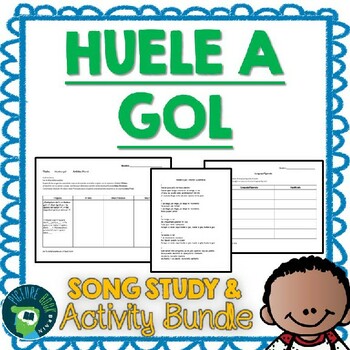Huele a gol by Morat Spanish Song Study + Google Activities
- PDF
- Google Apps™

Description
A Spanish song study with discussion questions for the song Huele a gol by Morat - a group from Colombia. A great song for studying poetry, figurative language, and soccer / football! Printable worksheets and student activities on Google Docs with provided sentence stems to help students respond in paragraph form using text evidence.
If your students struggle to respond thoughtfully to discussion questions, this resource is perfect!
How it works:
- Assign students the questions of your choice
- Send them to read and respond in writing to the questions using provided sentence frames or make their own
- Students meet to discuss using their responses
- Students borrow ideas to strengthen their ideas and make them clearer
- Students combine their ideas and the borrowed ideas to make a stronger, clearer thought
Novel Study and activities focus on:
- Summarizing key details (graphic organizers and discussion questions)
- analyzing quotes - verses and stanzas (versos y estrofas)
- analyzing text structure and figurative language
- identifying theme
- building vocabulary with definitions and synonyms
- extending the learning with independent research
The novel study includes:
- All activities in Spanish only - perfect for a Spanish poetry study or song study!
- printable prompts for student post-reading responses through discussion in writing
- Stronger-Clearer discussion strategy framework embedded
- Discussion questions with
- Sentence frames for students to respond in paragraph form using text evidence
- Questions for analyzing the song
- Song lyrics
- Sentence stems / frames for oracy and vocabulary development
- Great for bilingual classrooms
- Printable worksheets for written responses
- Google Docs for student responses
- Ability to pick and choose individual questions or for students to answer all questions
- Graphic organizers
How to Use This Resource:
- small group
- for individual students / 1 on 1
- as a reading intervention
- for a substitute / in a sub folder
- special education (SPED)
- bilingual or Dual Language / DLI classrooms
- with ELLs for ESL instruction
- Great for 4th, 5th, 6th, 7th or 8th grade or beyond in high school
- Google Classroom Distance learning / virtual learning
- on chromebooks, tablets or iPads for tech classrooms to go paperless
Your fourth, fifth, sixth, seventh or eighth grade students or older will love this!
✰ ✭ ✰ ✭ ✰ ✭ ✰ ✭ ✰ ✭ ✰ ✭ ✰ ✭ ✰ ✭ ✰ ✭ ✰ ✭
You May Also Like:
Comprehensive Literacy Language Workshop Plan for Oliver Button is a Sissy
1st Grade Common Core Reading Standards Rubrics
Dual Language Reading Resource using CAFE and Sentence Starters





